|
The Fishing Boats of India |
|
| By Joel Fleischer
- Marquette, Michigan - USA |
In October I went to southern India
and spent the next month traveling to churches in
that area helping to train Lutheran pastors there.
As we prepared to return home in November, we had
several days to do the tourist thing in and around
the city of Chennai, in the Tamil Nadu state. Of course,
we had to go to the beach and see the Bay of Bengal
on the Indian Ocean. When we arrived, I was amazed
to see that the beach was not covered with sunbathers.
It was covered with fishing boats and boat motors.
The boats ranged from twenty to thirty
feet long, and reminded me of the pangas that fish
off the coasts of Mexico. The boats were wood construction
and brightly painted. Many looked to have been professionally
built, but some of the boats were nothing more than
large pieces of wood lashed together, carved out to
a vague boat shape, and left unpainted.
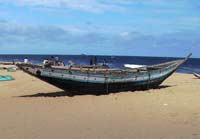 |
The biggest
fishing boat on the beach. |
| A typical Indian
fishing boat, around 25 feet to 30 feet long,
with a very shallow draft. |
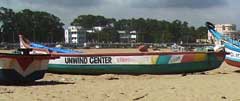
|
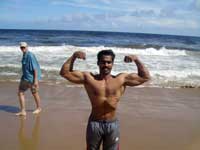 |
Muscle Beach?
This man was about five feet tall, and all muscle,
and insisted that we take his picture. |
| Oars? Rudders? These
oars ranged from 6 – 12 feet long. |
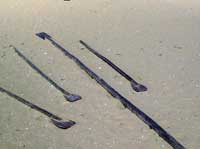
|
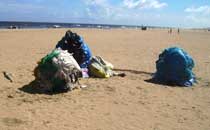 |
Guarding the
fishing gear. |
| In the afternoon,
fishing boats line the beaches and fishing nets
and motors are shrouded with polytarps. |

|
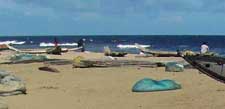 |
Note the two
“boats” on the right. I’m
not sure if the fishermen that use those boats
are brave or just desperate. |
| Todd Ohlmann with
some of the nicer examples of local fishing boats
behind him. |
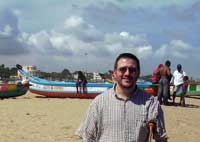
|
The week after the Tsunami of December
26, 2004, Pastor Ohlmann flew to India to bring financial
relief to people affected by the disaster. Three of
the families that he met with told him the following
story:

The three men of these families
have been fishermen for many years and have built
up the most successful fishing business in the village.
They pooled their resources and bought a boat that
they could take further out to sea and all three
could fish from. They also corporately own four
different sized nets to catch different types of
fish. They had been very successful by the standards
of this village. They lived in brick built homes
instead of the common thatched homes that most in
the village called home.

After the Tsunami the Indian
government constructed emergency shelters.
In some cases, the emergency shelters were
better than what they lost, so that, more
than two years later many people are still
living in the shelters. (click image to
enlarge)
|
On the day of the
Tsunami they had been out early, around 4:00 AM
to fish. They had been out about 3-4 Km from shore
and were heading in with their catch for the morning.
The first tsunami wave came in around 6:30 AM and
rolled their boat over. All three men were tossed
overboard but managed to climb onto the top of the
boat. This happened two more times as the 2nd and
3rd waves came in. Amazingly enough, they all managed
to climb on to the upside down boat and hang onto
ropes. This is not big fishing boat but rather more
like an over sized canoe, perhaps 8ft wide and 25ft
long. The boat rode the final wave past the shore
and into the line of trees some 500 or more yards
past the current shore line. Witnesses from the
village said the wave was more than 25ft high. All
three men were bruised and scared but alive. Their
nets and boat motor were destroyed.
Their boat, amazingly
enough, only suffered minor surface damage that
they have already managed to repair with fiberglass
patching. Their motor will need to be replaced at
a cost of around $1,200 and their four nets vary
in price due to the types of nets for various sizes
and types of fish but average to around $600.00
each. This comes to a total amount of around $3,600.
This, remember is the source of livelihood for three
(what used to be anyway) prosperous fishermen families.
They have no insurance, so they will have to start
from scratch and rebuild. I asked them how they
would begin to fish again and they said for the
time being they would only be able to go out as
far as they could safely row the boat with paddles
and they would try to salvage one of the 100's of
the ruined and tangled nets that litter the beaches
and tree line.

The day before we left India, we traveled
to the city of Mamalapuram, south of Chennai. There
are major archeological sites there with monolithic
temples and even a lighthouse, dating back 1400 years.
And, of course, the beach right next to the temple
was covered with fishing boats.
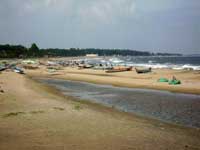 |
The beach at
Mamalapuram. |
| Is that a bikini?
All of the vehicles in India are painted in bright
colors, and the boats are no exception. Note the
long propeller shafts on the outboards. |
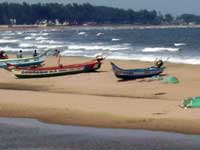
|
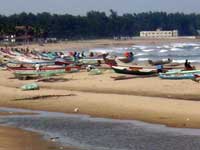 |
More boats at
Mamalapuram. |
| A fishing boat at
Mamalapuram. |
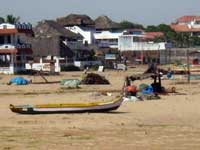
|
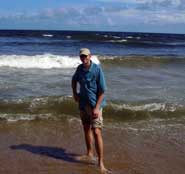 |
The author on
the beach in Chennai, India. |
|